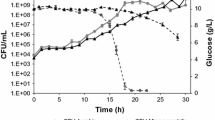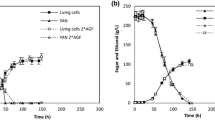Abstract
The survival of Kluyveromyces thermotolerans and Torulaspora delbrueckii in mixed cultures with Saccharomyces cerevisiae was examined at low oxygen availability in a defined grape juice medium. In these fermentations, K. thermotolerans and T. delbrueckii died off earlier than S. cerevisiae, and K. thermotolerans and T. delbrueckii exhibited parabolic death kinetics. Furthermore, the early deaths seemed to be non-apoptotic in nature. In order to understand the mechanism causing the early deaths, various single- and mixed-culture fermentations were carried out. The early deaths could not be explained by nutrient depletion or the presence of toxic compounds. Rather, they seemed to be mediated by a cell-to-cell contact mechanism at high cell densities of S. cerevisiae, and to a lesser ability of K. thermotolerans and T. delbrueckii to compete for space, as compared to S. cerevisiae. These results contribute to an increased understanding of why K. thermotolerans and T. delbrueckii die off before S. cerevisiae in wine fermentations.





Similar content being viewed by others
References
Anacleto J, van Uden N (1982) Kinetics and activation energetics of death in Saccharomyces cerevisiae induced by sulfur dioxide. Biotechnol Bioeng 14:2477–2486
Barillère J-M, Mimouni A, Dubois C, Bidan P (1985) Heat resistance of yeasts isolated from wines. 1. Effect of the experimental conditions on the shape of the survival curves. Sci Aliments 5:365–378
Boulton RB, Singleton VL, Bisson LF, Kunkee RE (1996) Yeast and biochemistry of ethanol fermentation. In: Principles and practices of winemaking, Chapman and Hall, New York, pp 102–192
Cocolin L, Bisson LF, Mills DA (2000) Direct profiling of the yeast dynamics in wine fermentations. FEMS Microbiol Lett 189:81–87
Cramer AC, Vlassides S, Block DE (2002) Kinetic model for nitrogen-limited wine fermentations. Biotechnol Bioeng 77:49–60
Fiechter A, Käppeli O, Meussdoerffer F (1987) Batch and continuous culture. In: Rose AH, Harrison JS (eds) The yeasts, vol 2. Academic, London, pp 99–129
Fiore M, Degrassi F (1999) Dimethyl sulfoxide restores contact inhibition-induced growth arrest and inhibits cel density-dependent apoptosis in hamster cells. Exp Cell Res 251:102–110
Fleet GH, Heard GM (1993) Yeasts: growth during fermentation. In: Fleet GH (ed) Wine microbiology and biotechnology, Harwood, Chur, Switzerland, pp 27–54
Fröhlich K-U, Madeo F (2000) Apoptosis in yeast—a monocellular organism exhibits altruistic behaviour. FEBS Lett 473:6-9
Granchi L, Ganucci D, Messini A, Rosellini D, Vincenzini M (1998) Dynamics of yeast populations during the early stages of natural fermentations for the production of Brunello di Montalcino wines. Food Technol Biotechnol 36:313–318
Hansen EH, Nissen P, Sommer P, Nielsen JC, Arneborg N (2001) The effect of oxygen on the survival of non-Saccharomyces yeasts during mixed culture fermentations of grape juice with Saccharomyces cerevisiae. J Appl Microbiol 91:541–547
Heard GM, Fleet GH (1987) Occurrence and growth of killer yeasts during wine fermentation. Appl Environ Microbiol 53:2171–2174
Henscke PA, Jiranek V (1993) Yeasts—metabolism of nitrogen compounds. In: Fleet GH (ed) Wine microbiology and biotechnology, Harwood, Chur, Switzerland, pp 77–164
Hirano M, Hirano K, Nishimura J, Kanaide H (2001) Transcriptional up-regulation of p27Kip1 during contact-induced growth arrest in vascular endothelial cells. Exp Cell Res 271:356–367
Krammer PH (2000) CD95's deadly mission in the immune system. Nature 407:789–795.
Ludovico P, Sousa MJ, Silva MT, Leão C, Côrte-Real M (2001) Saccharomyces cerevisiae commits to a programmed cell death process in response to acetic acid. Microbiol 147:2409–2415
Ludovico P, Sansenetty F, Silva MT, Côrte-Real M (2003) Acetic acid induces a programmed cell death process in the food spoilage yeast Zygosaccharomyces bailii. FEMS Yeast Res 3:91–96
Madeo F, Herker E, Maldener C, Wissing S, Lächelt S, Herlan M, Fehr M, Lauber K, Sigrist SJ, Wesselborg S, Fröhlich K-U (2002) A caspase-related protease regulates apoptosis in yeast. Mol Cell 9:911–917
Madeo F, Fröhlich E, Ligr M, Sigrist SJ, Wolf DH, Fröhlich K-U (1999) Oxygen stress: A regulator of apoptosis in yeast. J Cell Biol 145:757–767
Musmanno RA, Di Maggio T, Coratza G (1999) Studies on strong and weak killer phenotypes of wine yeasts: production, activity of toxin in must, and its effect in mixed culture fermentation. J Appl Microbiol 87:932–938
Nissen P, Nielsen D, Arneborg N (2003) Viable Saccharomyces cerevisiae cells at high concentrations cause early growth arrest of non-Saccharomyces yeasts in mixed cultures by a cell-cell contact-mediated mechanism. Yeast 20:331–341
Pardo I, García MJ, Zúñiga M, Uruburu F (1989) Dynamics of microbial populations during fermentation of wines from the Utiel-Requena region of Spain. Appl Environ Microbiol 55:539–541
Press WH, Flannery SA, Teukolsky SA, Vetterling WT (1988) Numerical recipes of C. Cambridge University Press, Cambridge, UK
Sá-Correia I, van Uden N (1986) Ethanol-induced death of Saccharomyces cerevisiae at low and intermediate growth temperatures. Biotechnol Bioeng 28:301–303
Schimz K-L (1980) The effect of sulfite on the yeast Saccharomyces cerevisiae. Arch Microbiol 125:89–95
Severin FF, Hyman AA (2002) Pheromone induces programmed cell death in S. cerevisiae. Curr Biol 12: R233-R235, S1
Shimkets LJ, Kaiser D (1999) Cell contact-dependent C signaling in Myxococcus xanthus. In Cell-Cell Signaling in Bacteria, Dunny GM, Winans SC (eds) American Society for Microbiology, Washington DC, pp 83–97
Skulachev VP (2002) Programmed death in yeast as adaptation. FEBS Lett 528:23–26.
Spencer-Martins I, van Uden N (1982) The temperature profile of growth, death and yield of the starch-converting yeast Lipomyces kononenkoae. Z allgemine Mikrobiol 22:503–505
Truong-Meyer X-M, Streihaiano P, Riba J-P (1997) Thermal inactivation of two yeast strains in a strawberry product: experimental data and kinetic model. Chem Eng J 65:99–104
Van Uden N, Madeira-Lopes A (1970) Concurrent exponential growth and death of cell populations of Saccharomyces cerevisiae at superoptimal growth tempartures. Z allgemeine Mikrobiol 10:515–526
Viegas CA, Sá-Correia I (1997) Effects of low temperatures (9–33 °C) and pH (3.3–5.7) in the loss of Saccharomyces cerevisiae viability by combining lethal concentrations of ethanol with octanoic and decanoic acids. Int J Food Microbiol 34:267–277
Viegas CA, Almeida PF, Cavaco M, Sá-Correia I (1998) The H+-ATPase in the plasma membrane of Saccharomyces cerevisiae is activated during growth latency in octanoic acid-supplemented medium accompanying the decrease in intracellular pH and cell viability. Appl Environ Microbiol 64:779–783
Zagorc T, Maráz A, Cadez N, Jemec KP, Péter G, Resnik M, Nemanĭc J, Raspor P (2001) Indigenous wine killer yeasts and their application as a starter culture in wine fermentation. Food Microbiol 18:441–451
Acknowledgements
This work was financed by The Royal Veterinary and Agricultural University.
Author information
Authors and Affiliations
Corresponding author
Rights and permissions
About this article
Cite this article
Nissen, P., Arneborg, N. Characterization of early deaths of non-Saccharomyces yeasts in mixed cultures with Saccharomyces cerevisiae . Arch Microbiol 180, 257–263 (2003). https://doi.org/10.1007/s00203-003-0585-9
Received:
Revised:
Accepted:
Published:
Issue Date:
DOI: https://doi.org/10.1007/s00203-003-0585-9




